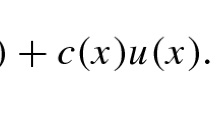Abstract
The present paper is mainly devoted to the study of initial boundary problems associated with a wide class of degenerate second-order differential operators on real intervals, in the framework of weighted continuous function spaces. Such operators are of particular interest, since they often occur, for instance, while building up theoretical models in Mathematical Finance. In order to develop our approach, essentially based on semigroup theory, we provide here some general tools which, perhaps, cover an interest on their own, being concerned with the generation of positive strongly continuous semigroups and their deep connection with Markov processes, in the setting of weighted spaces of continuous functions on a locally compact space.
Due to its length, the paper is split up into two parts; the second part will appear in this same journal.
Similar content being viewed by others
References
F. Altomare and M. Campiti, Korovkin-type Approximation Theory and its Applications, Vol.17, de Gruyter Series Studies in Mathematics, de Gruyter, Berlin-New York, 1994.
F. Altomare and I. Carbone, Markov processes and diffusion equations on unbounded intervals, Taiwanese J. Math. 5(2001), 1, 141–167.
F. Black and P. Karasinski, Bond and option pricing when short rates are lognormal, Financial Analysis Journal 81 (1991), 52–59.
F. Black and M. Scholes, The pricing of options and corporate liabilities, Journal of Political Economy 81 (1973), 637–654.
R. M. Blumenthal and R. K. Getoor, Markov Processes and Potential Theory, Pure and Applied Mathematics, Vol.29, Academic Press, New York, London, 1968.
J. M. Bony, P. Courrège and P. Priouret, Semi-groupes de Feller sur une variété a bord compacte et problèmes aux limites intégro-différentiels du second ordre donnant lieu au principe du maximum, Ann. Inst. Fourier, Grenoble 18, 2 (1968), 369–521.
M. Brennan and E. Schwartz, Analyzing convertible bonds, Journal of Financial and Quantitative Analysis 17 (1982), 75–100.
J. A. van Casteren, Generators of strongly continuous semigroups, Research Notes in Mathematics, n. 115, Pitman, Boston, 1985.
F. Colombo, M. Giuli and V. Vespri, Generation of smoothing semigroups by degenerate elliptic operators arising in financial mathematics, Comm. Appl. Anal. 3 (1999), 283–299.
J. Cox, J. Ingersoll and S. Ross, A theory of the term structure of interest rates, Econometrica 53 (1985), 385–408.
J. R. Dorroh, Contraction semi-groups in a function space, Pacific J. Math. 19 (1966), 35–38.
M. Dothan, On the term structure of interest rates, Journal of Financial Economics 7 (1978), 229–264.
E. B. Dynkin, Markov Processes, Vol. I and II, Springer-Verlag, Berlin, 1965.
K. Engel and R. Nagel, One-Parameter Semigroups for Linear Evolution Equations, Springer-Verlag, Berlin, 2000.
N. S. Ethier and T. G. Kurtz, Markov Processes, Characterization and Convergence, Wiley, 1986.
M. Garman, Towards a semigroup pricing theory, Journal of Finance 40 (1985), 847–862.
F. Gozzi, R. Monte and V. Vespri, Generation of analytic semigroups for degenerate elliptic operators arising in financial mathematics, Ulmer Seminare 2 (1997), 155–196.
T. Ho and S. Lee, Term structure movements and pricing interest rate contingent claims, Journal of Finance 41 (1986), 1011–1029.
C. Huang, Comments to Towards a semigroup pricing theory by M. Garman, Journal of Finance 40 (1985), 861–862.
J. Hull and A. White, One-factor interest-rate models and the valuation of interest-rate derivative securities, Journal of Financial and Quantitative Analysis 28 (1993), 235–254.
G. Lumer, Perturbation de générateurs infinitesimaux du type “Changement de temps”, Ann. Inst. Fourier, Grenoble, 23, 4 (1974), 271–279.
R. Merton, On the pricing of corporate debt: the risk structure of interest rate, Journal of Finance 29 (1974), 449–470.
A. Pazy, Semigroups of Linear Operators and Applications to Partial Differential Equations, Springer-Verlag, Berlin, 1983.
N. Pearson and T. Sun, An empirical examination of the Cox, Ingersoll and Ross model of term structure of interest rate using the method of maximum likelihood, Journal of Finance 54 (1994), 929–959.
K. Taira, Diffusion Processes and Partial Differential Equations, Academic Press, San Diego, CA, 1988.
O. Vasicek, An equilibrium characterization of the term structure, Journal of Financial Economics 5 (1977), 177.188.
P. Wilmott, S. Howison and J. Dewynne, The Mathematics of Financial Derivatives, Cambridge University Press, 1995.
Author information
Authors and Affiliations
Corresponding author
Rights and permissions
About this article
Cite this article
Altomare, F., Attalienti, A. Degenerate Evolution Equations in Weighted Continuous Function Spaces, Markov Processes and the Black-Scholes Equation — Part I. Results. Math. 42, 193–211 (2002). https://doi.org/10.1007/BF03322850
Received:
Published:
Issue Date:
DOI: https://doi.org/10.1007/BF03322850




